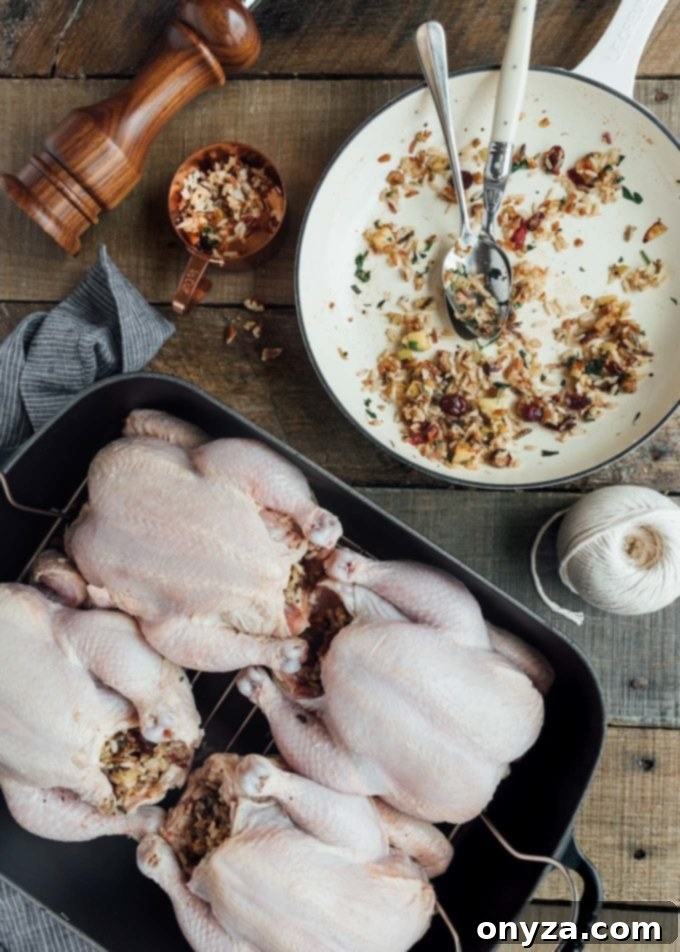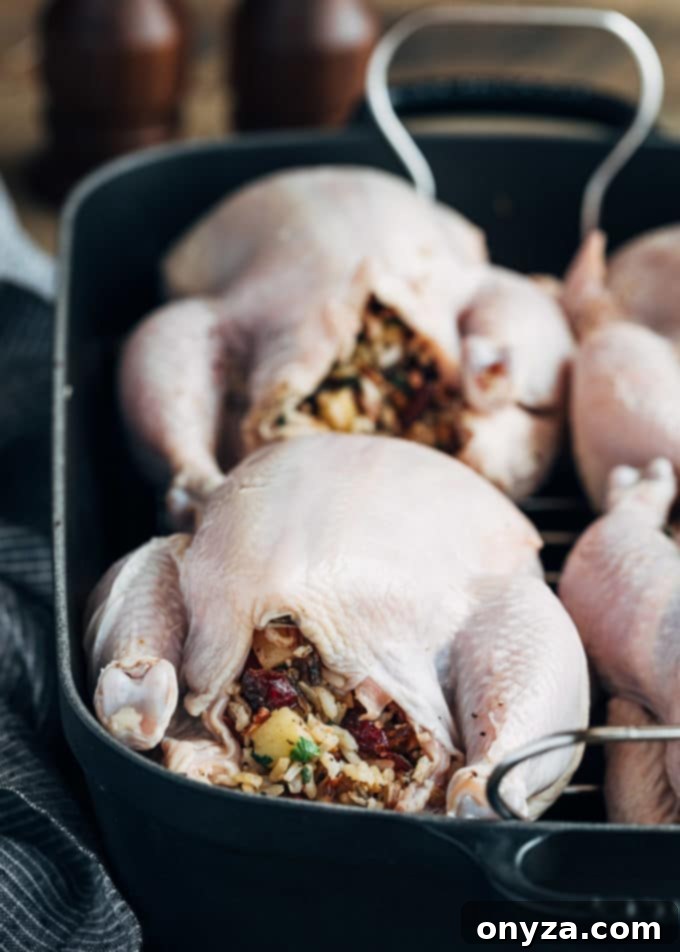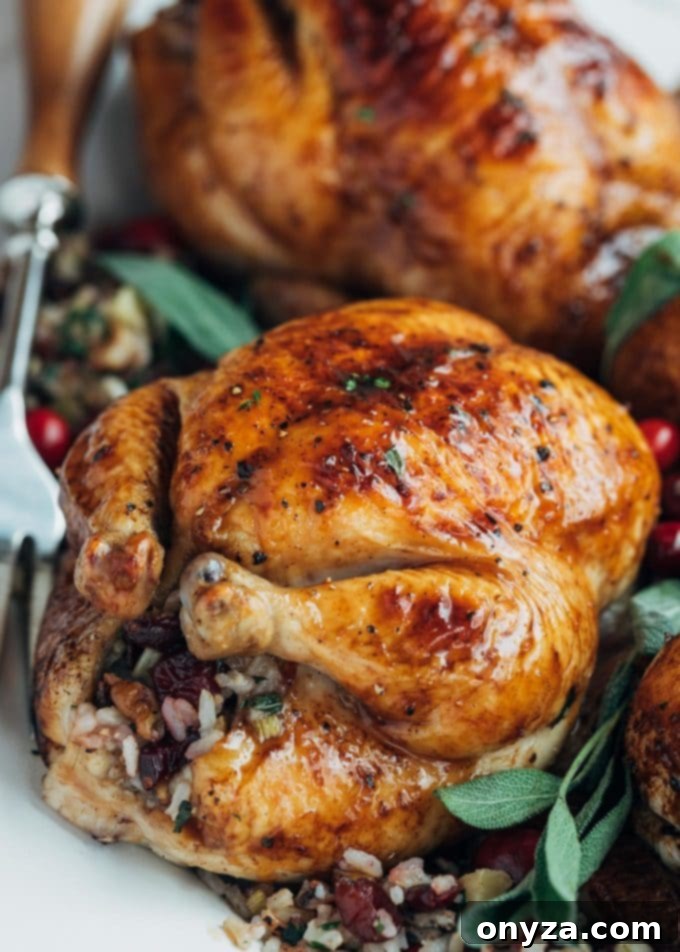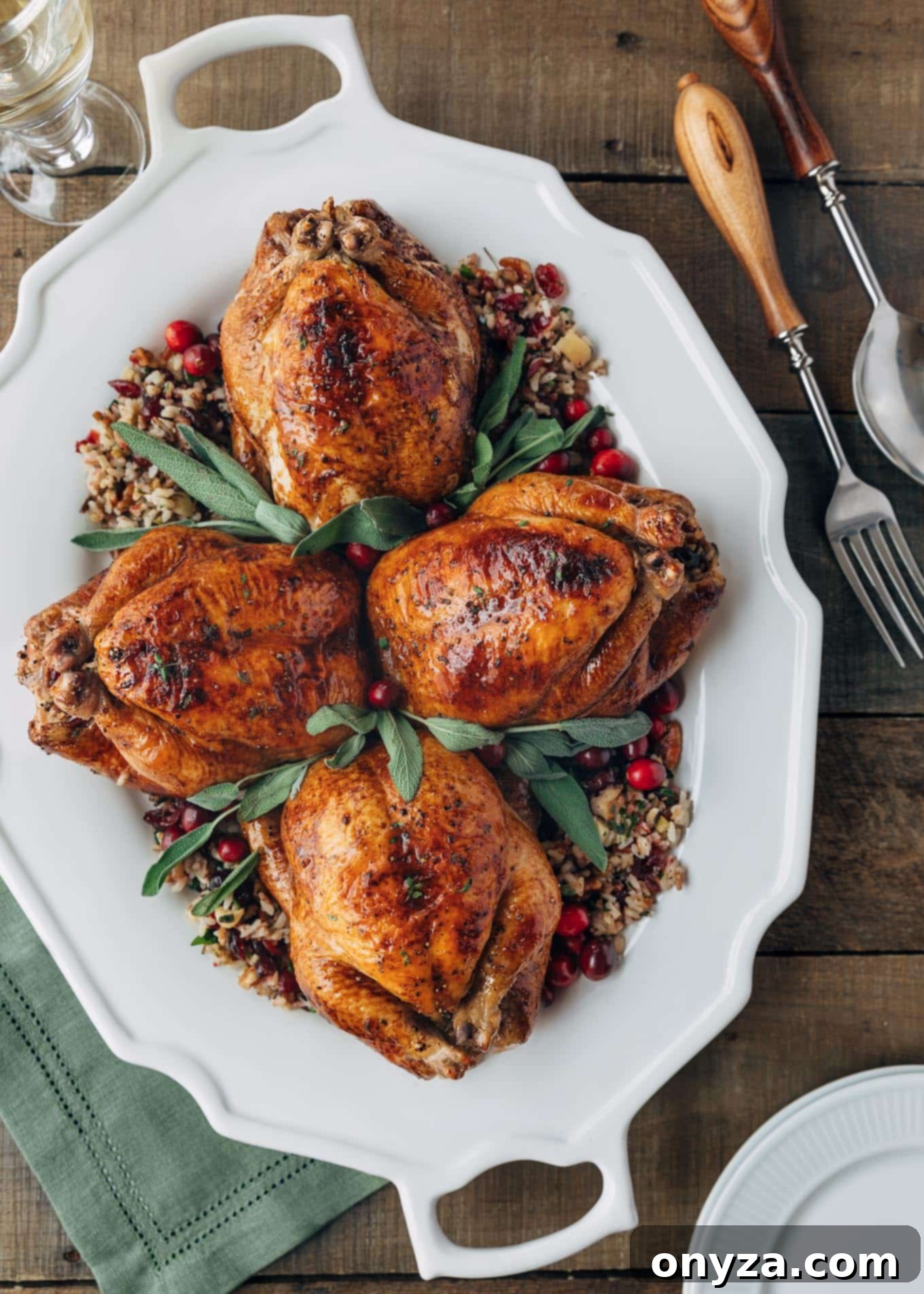Elevate your holiday entertaining with these exquisite stuffed Cornish hens. A stunning centerpiece for any fall or winter gathering, these diminutive birds are filled with a fragrant wild rice, cranberry, and apple stuffing, then roasted to golden perfection and brushed with a luscious apple cider glaze. They offer a sophisticated and perfectly portioned alternative to a traditional large turkey. Complete your luxurious meal with our expert sommelier wine pairings!
Elegant Stuffed Cornish Hens: The Perfect Holiday Main Course
Cornish hens hold a special place in the culinary world, particularly for those seeking an elegant yet manageable main dish during the festive seasons. I vividly recall their prominence in family gatherings during the 1980s, when my mother would expertly roast pan after pan, filling our home with their irresistible, buttery aroma. For a young child, these weren’t just ordinary roasted chickens; they were miniature marvels, each gracing an individual plate, signaling that a truly special holiday meal was at hand.
While my five-year-old self might have been simply delighted by the novelty of a “tiny chicken,” the inherent sophistication of Cornish hens has remained a cherished aspect of my holiday entertaining. Today, they continue to be a stellar choice for festive occasions, offering a myriad of advantages, especially for smaller Thanksgiving or Christmas celebrations. Instead of the often-daunting task of roasting a large turkey, these individual portions simplify meal preparation and create an undeniably impressive presentation that will wow your guests. Just imagine the stunning visual impact of a platter laden with perfectly roasted, golden-brown Cornish hens!

What Are Cornish Hens and Why Are They Perfect for Special Occasions?
In the United States, what we commonly refer to as “Cornish Hens” or “Cornish Game Hens” are a specific hybrid poultry breed, typically a cross between Cornish and Plymouth Rock chickens. These birds are harvested at a remarkably young age, usually between four to six weeks old, and weigh no more than two pounds. This early harvest contributes significantly to their desirable qualities: an incredibly tender texture and a delicate, mild flavor that is truly distinctive. Despite the “game hen” moniker, it’s important to note that these are domesticated chickens, not wild game birds, and can be either male or female.
The small size of Cornish hens makes them an ideal choice for individual servings, adding a touch of elegance and personal luxury to any meal. This characteristic is particularly beneficial for holiday entertaining, as it eliminates the need for carving at the table, ensuring each guest receives a perfectly portioned and beautifully presented bird. Their quicker cooking time compared to a large turkey also reduces stress in the kitchen, allowing hosts more time to enjoy their guests.

Cornish Hen vs. Poussin: Understanding the Difference
While Cornish hens are sometimes confused with “poussin” or “spring chickens,” there are subtle but important distinctions. Poussin refers more broadly to any breed of immature, small chicken, not exclusively the Cornish and Plymouth Rock hybrid. Poussins are traditionally known for being slightly leaner than Cornish hens and typically fall into a smaller weight category, often around one to one-and-a-quarter pounds. Despite these differences, both Cornish hens and poussins boast a wonderfully delicate flavor and a moist, tender texture, making them largely interchangeable in many recipes, including this one. However, be mindful that poussins, being smaller, may roast a bit faster. For the most delectable results, I always recommend sourcing natural, air-chilled poultry from your local grocery store or specialty butcher.

Crafting the Perfect Stuffed Cornish Hens: A Flavorful Journey
Given the inherently delicate nature and smaller cavity of Cornish hens, I find that a light, flavorful rice-based stuffing complements them far better than a dense bread stuffing, which can overwhelm their subtle taste and texture. This recipe features a delightful wild rice, cranberry, and apple stuffing that strikes the perfect balance of savory, sweet, and aromatic notes.
Preparing the Delectable Rice Stuffing
The preparation of this exquisite stuffing is surprisingly quick and can even be done in advance, easing your holiday meal prep. Begin by sautéing finely chopped onions and celery in rich unsalted butter until they soften and become translucent, forming the aromatic base of your stuffing. Next, introduce coarsely chopped pecans, fresh sage, and thyme, allowing them to toast gently until their fragrant oils are released, adding depth and warmth. A crucial step often overlooked is deglazing the pan with a splash of apple cider, which lifts all those delicious browned bits from the bottom, intensifying the overall flavor profile.
Once the aromatics and nuts are perfectly fragrant, remove the skillet from the heat and gently fold in your pre-cooked rice, diced Fuji apples for a touch of crisp sweetness, and plump sweetened dried cranberries for a burst of tartness. Fresh flat-leaf parsley brightens the mixture, and a generous seasoning of kosher salt and freshly-ground black pepper ensures every bite is perfectly balanced. When stuffing the hens, remember to fill each cavity loosely with approximately 1/2 cup of the mixture. Overpacking can hinder even cooking and lead to a dense, unappealing stuffing texture, so allow ample room for air circulation.

Choosing the Right Rice for Your Stuffing
For the stuffing’s foundation, I highly recommend a blend of different rice varieties. My personal preference is a “Royal Blend” which typically includes white, brown, wild, and red rice, offering a fantastic array of textures and subtle nutty flavors. Alternatively, a standard long grain and wild rice blend works beautifully. The key to a superior stuffing lies in how the rice is prepared: always rinse the rice thoroughly under cold water until the water runs clear. This removes excess starch, preventing a gummy texture. Then, simmer it in chicken broth instead of plain water to infuse it with an extra layer of savory depth. It’s imperative to cook the rice until it’s tender but still retains a slight bite; avoid overcooking at all costs, as mushy rice will compromise the entire stuffing experience.

Mastering the Art of Roasting Glazed Cornish Hens
Achieving perfectly roasted, succulent Cornish hens with a beautifully golden and crispy skin is a straightforward process when you follow a few key techniques. While larger poultry often requires intricate trussing, Cornish hens benefit from a simpler approach. I typically tuck the wing tips neatly under the bird to prevent them from burning and tie the legs together with kitchen twine, which helps maintain their shape and promotes even cooking.
Roasting for Perfection and That Irresistible Glaze
For optimal air circulation and consistent cooking, always roast your hens on a rack placed within a roasting pan or on a rimmed baking sheet. This elevated position ensures that hot air can circulate freely around the entire bird, leading to that coveted crispy skin. Before the initial roast, liberally brush each hen with melted unsalted butter and season generously with kosher salt and freshly-cracked black pepper. The butter not only enhances flavor but also aids in achieving that rich, golden-brown crust during the higher initial roasting temperature.
Begin roasting in a preheated 425°F (220°C) oven for 20 minutes. This high heat jump-starts the browning process, locking in juices and crisping the skin. After this initial searing period, reduce the oven temperature to 375°F (190°C) to allow the hens to cook through gently. They will require an additional 40-50 minutes in the oven, depending on their size. The magic truly happens during the final 30 minutes of cooking, when you begin brushing the hens with a simple yet exquisite cider-Dijon-maple glaze. This glaze, easily prepared ahead of time on the stovetop, imparts a glorious sweet-tart finish and a stunning, caramelized color to the skin. Reapply the glaze every 10 minutes during this final phase for maximum flavor and sheen. Should you notice the hens browning too rapidly, simply loosely tent them with a piece of aluminum foil to prevent over-browning.

Serving Your Exquisite Cornish Game Hens
One of the many charms of Cornish hens is their ideal individual portion size. For most hens weighing between 1.25 to 1.5 pounds, one bird perfectly serves one person, creating a truly personal and luxurious dining experience. For larger hens, or if serving guests with lighter appetites, you can easily split them in half before plating. After roasting, it is crucial to allow the hens to rest for at least 10 minutes. This resting period enables the juices to redistribute throughout the meat, ensuring every bite is incredibly tender and flavorful. Once rested, simply snip away the kitchen twine and transfer the whole hens directly to dinner plates or a grand serving platter, ready for your guests to admire and enjoy.
Enhancing the Meal with Extra Stuffing and Wine Pairings
While each Cornish hen holds a generous serving of rice stuffing, I highly recommend preparing an extra batch to serve alongside the birds. This not only enhances the visual appeal of your table but also caters to guests who might desire an additional scoop of the delectable stuffing. To keep the extra stuffing warm and moist, simply place it in a buttered oven-safe dish, cover it, and warm it in a 325°F (160°C) oven for 20-30 minutes before serving.

To truly elevate this elegant meal, consider pairing it with a thoughtfully selected wine. Certified Sommelier and Italian Wine Ambassador, Hugh Preece, offers these exceptional suggestions:
Traditional Pairing: St. Michael-Eppan Riesling ‘Montiggl’ Sudtirol, Alto Adige
This exquisite Riesling from Alto Adige presents a clean yellow-green hue and an intense bouquet of stone fruit and delicate white flowers. On the palate, it reveals elegant notes of grapefruit, sage, thyme, and almond, underpinned by a beautifully balanced minerality and crisp acidity. Its touch of roundness and persistent finish make it a perfect complement to the rich poultry and the herbaceous, fruity stuffing, cutting through the richness with refreshing clarity.
Daring Pairing: Tenuta San Giorgio Sangiovese ‘Ciampoleto’ Rosso di Montalcino DOC, Tuscany
For those seeking a bolder choice, this “baby Brunello” Rosso di Montalcino is a superb option. It boasts a nice bright, ruby red color, with an inviting nose of ripe berries and autumnal flowers. Smooth, supple, and fresh on the palate, it delivers a complex array of flavors including thyme, cherry, raspberry, sun-dried tomato, clove, leather, and a hint of clay, culminating in a delicate strawberry finish. Its delicate tannins provide a lovely structure, and its moderate body and accessibility make it an intriguing match for the savory elements of the hen and stuffing.
Cornish Hens with Apple-Cranberry Rice Stuffing
This glazed, rice-stuffed Cornish hen recipe is perfect for elegant entertaining during the fall and winter months, offering a delightful alternative to traditional holiday roasts.
Cook Time: 1 hour 20 minutes
Total Time: 2 hours
Servings: 4 servings
Ingredients
Stuffing
- 2 tablespoons unsalted butter
- ¼ cup chopped onion
- ¼ cup chopped celery
- ⅓ cup coarsely chopped pecans
- 1 tablespoon chopped fresh sage
- 2 teaspoons chopped fresh thyme
- 1-1/2 cups cooked rice (long grain and wild, or “Royal/Wild Blend”)*
- ½ cup peeled, diced Fuji apples (1/4-inch dice, about 1/2 large apple)
- ½ cup sweetened dried cranberries
- 3 tablespoons chopped fresh flat-leaf parsley
- Kosher salt and freshly-ground black pepper, to taste
- Splash of apple cider
Glaze
- 1 cup apple cider
- 2 tablespoons maple syrup
- 1 teaspoon Dijon mustard
- Pinch of ground cinnamon
Hens
- 4 Cornish hens (1.25 to 1.5 pounds each)
- 2 tablespoons unsalted butter, melted
- Kosher salt and freshly-ground black pepper, to taste
Instructions
Make the Stuffing
- Melt butter in a large skillet over medium heat until foaming subsides. Add chopped onions and celery, and cook until softened, about 5 minutes.
- Stir in coarsely chopped pecans, fresh sage, fresh thyme, and season with 1/4 teaspoon each of kosher salt and freshly-ground black pepper. Continue to cook for about 3 more minutes, stirring occasionally, until the pecans are lightly toasted and fragrant.
- Deglaze the pan with a small splash of apple cider, scraping any browned bits from the bottom of the skillet with a wooden spoon.
- Remove the skillet from the heat. Stir in the cooked rice, diced Fuji apples, sweetened dried cranberries, and chopped fresh flat-leaf parsley. Taste and adjust seasoning with additional salt and pepper as needed. Set aside to cool slightly.
Make the Glaze
- In a small saucepan, combine the apple cider and maple syrup. Bring the mixture to a boil over medium-high heat, then reduce the heat to maintain a steady, gentle bubble.
- Simmer the glaze, stirring occasionally, until the mixture is syrupy and has reduced to approximately 1/3 to 1/2 cup, which should take about 15 minutes.
- Remove from heat and whisk in the Dijon mustard and ground cinnamon until the glaze is smooth and fully combined. Set aside.
Stuff and Roast the Hens
- Remove the Cornish hens from the refrigerator about 30 minutes prior to roasting to allow them to come closer to room temperature. Remove any giblets from the cavities, rinse the hens thoroughly under cold water, and then pat them completely dry with paper towels.
- Preheat your oven to 425°F (220°C). Position an oven rack in the lower third of the oven. Place a roasting rack inside a foil-lined roasting pan or on a rimmed baking sheet. Lightly spray the roasting rack with cooking spray to prevent sticking.
- Lightly season the cavities of the hens with salt and pepper. Loosely spoon about 1/2 cup of the prepared rice stuffing into each cavity. Do not pack the stuffing tightly. Tie the legs of each hen closed with kitchen twine and tuck the wing tips neatly under the birds. Arrange the stuffed hens on the prepared roasting rack, ensuring there is enough space between each bird for air to circulate freely.
- Brush the tops and sides of each hen thoroughly with melted unsalted butter and season them generously with additional kosher salt and freshly-ground black pepper.
- Roast the hens for 20 minutes at 425°F (220°C). After 20 minutes, reduce the oven temperature to 375°F (190°C).
- Continue roasting for an additional 40-50 minutes, or until the hens are cooked through. During the final 30 minutes of cooking, begin brushing the hens with the prepared apple cider glaze every 10 minutes. If you notice the hens browning too quickly, you can loosely tent them with a piece of aluminum foil.
- The hens are done when an instant-read thermometer inserted into the thickest part of the thigh (avoiding the bone) registers 180°F (82°C), and the juices run clear.
- Remove the hens from the oven and let them rest for 10 minutes before snipping away the kitchen twine and serving. Resting is crucial for juicy, tender meat.
Notes
*For the rice, cook it according to package directions until tender. Using chicken broth as the cooking liquid instead of water will significantly boost the flavor of your stuffing.
For the most appealing golden-brown skin, I’ve found that roasting the hens on a rack set on a rimmed baking sheet works best, as it exposes the sides more fully to the heat and allows for superior air circulation. While hens cooked in a traditional roasting pan will still be utterly delicious, they might not achieve quite the same deep golden color on their sides.
Nutrition Estimate
Calories: 1181kcal | Carbohydrates: 31g | Protein: 79g | Fat: 80g | Saturated Fat: 25g | Cholesterol: 484mg | Sodium: 299mg | Potassium: 1202mg | Fiber: 2g | Sugar: 20g | Vitamin A: 1165IU | Vitamin C: 9.3mg | Calcium: 77mg | Iron: 4.2mg
Nutrition information is automatically calculated and should be used as an approximation only.
About Our Recipes
Please note that our recipes have been developed using the US Customary measurement system and have not been tested for high altitude/elevation cooking and baking.
Enjoy this magnificent dish that combines tradition with exquisite flavor. Don’t forget to rate and comment below if you try this recipe!
